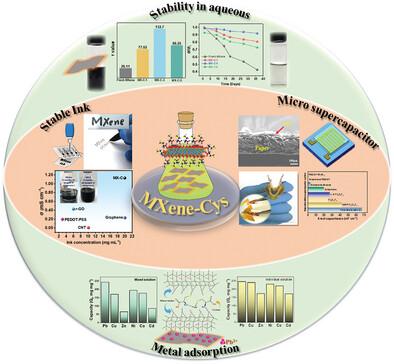当前位置:
X-MOL 学术
›
Adv. Funct. Mater.
›
论文详情
Our official English website, www.x-mol.net, welcomes your feedback! (Note: you will need to create a separate account there.)
Ultra Stable Ink with Promising Areal Capacitance as Advanced Micro‐Supercapacitor and Unique Metal Absorptivity Enabled by Surface Functionalization of Titanium Carbide (MXene)
Advanced Functional Materials ( IF 18.5 ) Pub Date : 2024-06-28 , DOI: 10.1002/adfm.202406481 Rana R. Neiber 1, 2, 3 , Jai Kumar 4 , Bharat Prasad Sharma 5, 6 , Wei‐Lu Ding 6 , Xingmei Lu 1, 2, 3, 7, 8
Advanced Functional Materials ( IF 18.5 ) Pub Date : 2024-06-28 , DOI: 10.1002/adfm.202406481 Rana R. Neiber 1, 2, 3 , Jai Kumar 4 , Bharat Prasad Sharma 5, 6 , Wei‐Lu Ding 6 , Xingmei Lu 1, 2, 3, 7, 8
Affiliation

|
2D Ti3 C2 Tx −2 (<N> = 5)) and power density (170.6 µW cm−2 ) compared to the reported printed MSC system. Similarly, the MX‐C facilitates a high capacity for selectively adsorbing lead while also exhibiting excellent performance in terms of adsorption–desorption. The adsorption‐induced effectiveness of cysteine is additionally validated by density functional theory simulations. The versatile approach emphasizes the potential of MX‐C inks with antioxidation properties for the invention of MSCs and metal uptake for printable electronics and clean water applications, respectively.
中文翻译:

超稳定墨水,具有作为先进微型超级电容器的有前途的面积电容和通过碳化钛 (MXene) 表面功能化实现的独特金属吸收性
2D Ti3C2Tx-MXenes 由于其独特的特性而作为极具前景的材料而受到关注。即便如此,这些材料有限的离子动力学和活性位点暴露受到氧化引起的显着降解以及墨水配方加工性和纳米片重新堆叠方面的挑战的阻碍。在这里,本研究提出了一种将半胱氨酸修饰到碳化钛(MX-C)纳米片上的单步且经济的方法。研究发现半胱氨酸有助于调节 MXene 纳米片的层间距。然后,这个想法被应用于微型超级电容器(MSC)的开发和有毒金属离子(特别是铅)的去除。此外,研究表明,MX-C 具有抗氧化行为,并且具有优异的墨水品质。与报道的印刷 MSC 系统相比,MX-C 印刷的 MSC 表现出超高的面积电容(68 mF cm−2 (<N> = 5))和功率密度(170.6 µW cm−2)。同样,MX-C 具有高选择性吸附铅的能力,同时在吸附-解吸方面也表现出优异的性能。半胱氨酸吸附诱导的有效性还通过密度泛函理论模拟得到验证。这种多功能方法强调了具有抗氧化特性的 MX-C 油墨在 MSC 发明和可印刷电子产品和清洁水应用中金属吸收方面的潜力。
更新日期:2024-06-28
中文翻译:

超稳定墨水,具有作为先进微型超级电容器的有前途的面积电容和通过碳化钛 (MXene) 表面功能化实现的独特金属吸收性
2D Ti3C2Tx-MXenes 由于其独特的特性而作为极具前景的材料而受到关注。即便如此,这些材料有限的离子动力学和活性位点暴露受到氧化引起的显着降解以及墨水配方加工性和纳米片重新堆叠方面的挑战的阻碍。在这里,本研究提出了一种将半胱氨酸修饰到碳化钛(MX-C)纳米片上的单步且经济的方法。研究发现半胱氨酸有助于调节 MXene 纳米片的层间距。然后,这个想法被应用于微型超级电容器(MSC)的开发和有毒金属离子(特别是铅)的去除。此外,研究表明,MX-C 具有抗氧化行为,并且具有优异的墨水品质。与报道的印刷 MSC 系统相比,MX-C 印刷的 MSC 表现出超高的面积电容(68 mF cm−2 (<N> = 5))和功率密度(170.6 µW cm−2)。同样,MX-C 具有高选择性吸附铅的能力,同时在吸附-解吸方面也表现出优异的性能。半胱氨酸吸附诱导的有效性还通过密度泛函理论模拟得到验证。这种多功能方法强调了具有抗氧化特性的 MX-C 油墨在 MSC 发明和可印刷电子产品和清洁水应用中金属吸收方面的潜力。











































 京公网安备 11010802027423号
京公网安备 11010802027423号